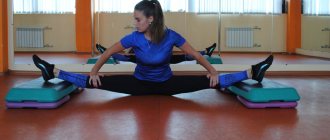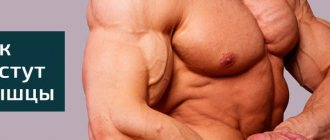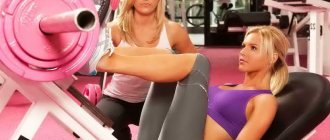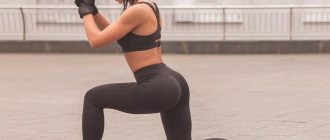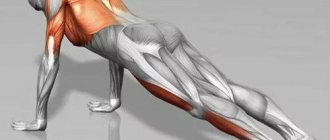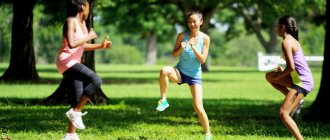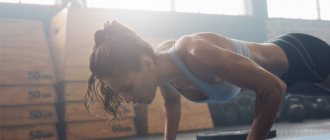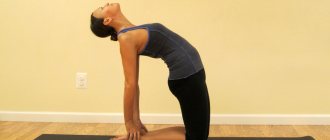According to research, muscles grow 5-15 percent faster after quality stretching. However, for some reason, this important step in developing a fit and healthy body after training is often overlooked. Many people mistakenly believe that stretching is exclusively a choreographic tool to be able to do the splits beautifully.
Stretching (translated from English - stretch, lengthen) is an important and necessary final set of exercises. Why stretching is needed after strength training and how to do it correctly will be discussed in detail below.
Why do you need stretching?
Stretching is a mandatory step after physical activity. It is recommended that everyone involved in various types of fitness do muscle stretching exercises at the end of the main workout. Why is this so important:
- Improves elasticity and mobility of joints.
- Blood circulation increases. As a result, muscle pain disappears after physical activity.
- Blood pressure is restored and heart rate decreases.
- Endorphins are produced, which give the body a feeling of harmony and satisfaction.
If you ignore this stage, you can provoke not only general discomfort in the body, but also injury. Therefore, it is better to use the professional support of an experienced trainer.
Interesting facts about the cool down
A few years ago, scientists from Norway conducted a study involving just over 1,800 handball players. They were divided into two groups, the first of them performed a cool-down, and the second neglected this stage. So 8 months passed, after which the scientists moved on to systematize the data and examined each participant.
The results were clear: those who systematically cooled down were about 50% less likely to be injured. In addition, the athletes who did the cool-down had a much better mental state than the second group of people (considering that before the experiment, the mental state of each of them was approximately the same level). And lastly, the general condition of the body was many times better in those who did the cool-down.
Stretching rules
Stretching is always performed only after training. Before the main power load, the body and muscles need to be prepared and warmed up - this will be a warm-up, and after the session - in relaxation. Principles of stretching:
- All exercises must be performed statically, allocating at least 20–30 seconds to each element. The amplitude should be even, smooth, without hasty movements and strong pressure on the involved muscle. It is recommended to do the complex for 5-10 minutes at the end of each training to relieve muscle tension. Once a week it is useful to do long stretching - 20-30 minutes. Tasks should be performed alone to avoid injury to your partner.
- During the process, it is very important to monitor the correct breathing rhythm. You need to take a deep breath and stretch as you exhale. This will help make stretching more effective, improve blood circulation and enhance relaxation. When muscles are tense and tight, they are difficult to stretch. The more the body relaxes, the more flexible it becomes, and the less pain is felt.
- If some movements don’t work out right away and cause discomfort, you shouldn’t force them. Gradually the muscles will get used to it, and doing the exercises will become easier.
- While bending towards your feet, you should try to keep your back straight. You need to reach your hips with your stomach. If you can’t do it correctly, you can ask for a little pressure on your lower back. Otherwise, there is a risk of harming the spine.
Stretching not only helps to relax the muscles after strength training, it also frees up the tissue for further growth. Men who regularly perform stretching reduce the risk of salt deposits in joints and the occurrence of arthritis and arthrosis by three times.
Women, as a rule, come to the gym to lose weight and gain a beautiful figure. And it doesn’t matter whether the lady does bodybuilding or aerobics. Stretching is useful for girls - plasticity improves, stiffness and tightness go away, and the process of losing weight accelerates. Movements become graceful, light and graceful. Regular exercise improves coordination and, in case of injury, accelerates the skin regeneration process. Stretching also has a positive effect on the shape of the legs. During stretching, the thigh and calf muscles lengthen slightly and become slimmer.
Approximate diagram
Regardless of the type of training performed, the cool-down can be structured according to the following scheme.
Light cardio
Objective: normalize blood circulation.
Exercises:
- low intensity jumping;
- run
- squats;
- jumping rope;
- walking
- bends;
- turns;
- swing your arms and legs.
The body prepares for a safe transition from an intense pace to a state of rest.
Breathing exercises
Task: normalize breathing.
Exercises:
- breathing for 4 counts;
- depth: deep and slow inhalations and exhalations with a retracted and absolutely motionless abdomen;
- Sphinx: belly breathing in a sitting position;
- wave: alternate breathing with the chest and stomach in a lying position.
The blood is saturated with oxygen, the central nervous system comes to a state of rest, and muscle spasms are eliminated.
Stretching
Objective: to give elasticity to muscles and tendons. Exercises:
- child's pose;
- downward facing dog pose;
- hanging extension;
- inverted back stretch;
- camel pose;
- backbends;
- pigeon pose;
- deep lunges.
Tense muscle fibers relax, blood vessels become toned.
At the end, you can perform several shaking movements, patting and rubbing, which have a massage effect. They have a general strengthening effect.
Technique for performing stretching by muscle group
After a forceful load on the body, short and light stretching will be a good prevention of pain and will help to competently complete the entire training process.
Neck and trapezius area
The main exercises for stretching are tilting the head back and forth, left and right.
The first thing you need to do is stand up straight. Slowly reach your chin to your chest to the best of your ability. As soon as you feel the limit, you need to carefully stretch even lower. Do the same back, trying to touch the back of your head with the back of your head. Place your right hand on your head and pull it towards your shoulder. Repeat on the left side.
After all four sides have been worked out, make circular movements with your head.
Back, lower back
Stand up straight. Breathing should be smooth. Bend the body in the chest area, then bend back as far as possible. Next, bring your shoulders together, stretch your arms forward and down. The chin should be moved in the same direction. Stretch and return to starting position.
In this exercise, you need to feel the tension in the muscles near your shoulder blades. If it is not there, then try to adjust the movements so that the sensation is created in this particular place.
Exercise "Cat". Get on all fours. Arch your back upward, your head should look down. Then bend down, head up. All movements must be done slowly and measuredly in order to stretch the muscles well.
Breast
To stretch, you will need a wall bars or parallel bars. Place your hands on the bar, keeping your feet on the floor. Slowly lower yourself as far as your pectoral muscles allow. Perform the exercise smoothly, without haste. Stand in the lowest position for 30 seconds. Return to starting position.
The following exercise will help relieve muscle tension in the chest after a workout. Lie on your stomach, arms extended to the sides. Push up from the floor with your right hand, bending your right knee for balance as you turn to the left. At this moment, you need to feel a stretch in the chest muscle.
Abdominal muscles, abs
You can use the following techniques:
- Exercise with bends. To do this, you need to sit on a chair, put your hands on the back of your head, and lock your fingers. Bend to the right, try not to lift your buttocks and thighs. Fix in this position for 30 seconds. Repeat on the left side.
- Exercise on the floor. Lie on your stomach with your palms facing forward. Slowly rise up, leaning on your hands. Arch your back and tighten your buttocks for 30 seconds.
- Plank position. The feet are shoulder-width apart, palms under them. Try to push your pelvis up as much as possible, while also pulling your heels and chest toward the floor. Your knees should remain straight at all times.
Legs - thighs, lower legs, buttocks
Exercises while lying on your back will help you stretch your muscles:
- First option. Lie on the floor, try to pull one leg bent at the knee to your chest, and leave the other straight. Thus, the gluteus maximus muscle is stretched.
- The second option is to lie on your back and alternately pull your legs to your chest, while trying not to lift your lower back off the floor.
An excellent stretching exercise is the splits. To avoid injury, it is important to ride it within your capabilities.
Other options:
- Side deep lunge to the side. Take a wide step so that one leg is bent at the knee at a right angle. If physical fitness allows, then try to sit closer to the heel. This exercise works well on the hip adductor muscle.
- Quadriceps strain. Get on your knees, sit on your heels, keep your back straight, then carefully lower yourself onto your elbows. If you feel severe discomfort while performing it, then it is better to postpone this position.
- Biceps hamstring strain. Sit on the floor, stretch your legs and fix them in a level position in front of you. Do not round your back. Place your palms around your shin or feet. Bend your torso forward, gradually increasing the stretch.
- Working out the gluteal muscle. Lie on your back. Bend both legs at the knees. Raise the left one a little, place the heel of the right one on it above the knee. Grasp the thigh of your left leg with your hands and pull it a little closer to the body, increasing the stretch of the gluteal muscle. Do the same on the other leg.
- Ankle work. You need to sit on the floor, bend one leg at the knee and gradually try to bend it at the ankle. Here it is important not just to rotate your foot, but to fixate in one state. When you change the position of your leg, different muscles will be stretched.
Arms and shoulders
Any vertical support is suitable for stretching (you can use a wall). Exercises:
- Stand with your right side, put your hand on the surface and lean on it. Make slow turns to the left. In this case, you need to feel the stretching of the muscles of the right shoulder and biceps. Fix in this position for 30 seconds. Repeat on the other half of the body.
- Raise your left arm up and bend it at the elbow. The right palm should be on the opposite shoulder behind the head. With your left hand, grab your right elbow and pull. Hold at the point of tension for 30 seconds.
It doesn’t matter whether a person works out in the gym or attends other fitness activities, such simple stretching exercises will relieve tension and help you relax. The emphasis should be on the muscle group that was most involved during the main workout.
Using various photos and videos on the Internet, you can choose a complex for yourself and perform it at home. However, to get the maximum effect, you need to work with a trainer. For example, start visiting the La Salute fitness club, where experienced instructors will help you perform exercises without the risk of unnecessary stress and injury.
Basic myths about cool-downs
Some people stubbornly continue to believe in myths about the hitch, but scientists are gradually reducing this belief to nothing with their research.
So one of the myths says that a cool-down will help completely eliminate pain after training . But studies conducted in 2007 showed that it has a positive effect on the condition of the body’s muscles, but does not in any way reduce the possible pain after training.
The second equally common myth is that thanks to the cool-down you can achieve unprecedented flexibility. But already the results of studies in 2012 show that it affects flexibility; the only thing is that those who constantly cooled down could jump better and easier in height.
What to do after stretching
Stretching after basic exercises requires a set of recovery procedures. It is imperative to adjust the water-salt balance. Replenish the deficiency of proteins and carbohydrates.
It is important to know that in order not to harm your health, you should never go out into the cold right away. While the muscles are very hot, you can get pinched under the influence of low temperatures.
If you feel emotional release after stretching, this is an indicator that all the exercises are being done correctly.
Exercises
Traditional dynamic exercises after training should be performed as slowly as possible, without jerking:
- swing your arms;
- turns to the sides;
- bending to the sides and forward;
- dynamic squats
- lunges.
After the dynamics, static stretching is performed. The basis for the cool-down can be taken from stretching or yoga:
- incomplete twists;
- sumo stand;
- martin;
- half squat;
- sitap;
- static hyperextension;
- a chair against the wall;
- cat;
- V-stabilization.
Don’t forget also about breathing exercises, which fit perfectly into the anti-stress post-workout complex.
Consequences of not warming up before exercise
If such motivation does not seem too clear (after all, during physical activity, the muscles will warm up in any case!), It is worth learning about what can happen to the body if you start exercising without proper preparation.
- Injuries to bone, muscle and connective tissue. In a “cold” state, the muscles harden and contract poorly, which is why they do not allow you to perform a good part of the usual exercises. If you pull them, you can get at least a spasm, and at most a sprain or tear.
- Joint diseases. When training without first working out all the joints, the risk of inflammation and deformation of the cartilage increases. Systematic loading will lead to decreased joint mobility, arthritis and arthrosis.
- Deformation of the ligamentous apparatus. “Cold” ligaments, like muscles, are inactive and prone to stiffening. Therefore, stress without warming up can easily injure fragile tissues.
Components of the recovery period
Don’t be surprised, but in order for recovery after training to be optimal, the following conditions must be met:
- start the lesson with a full warm-up; optimize the amount of training loads;
- drink water or a sports drink during class;
- do in the main part, during rest breaks, exercises for muscle relaxation, self-massage, breathing exercises;
- a cool down after training is mandatory;
- “behave correctly” in the phases of rapid and slow recovery;
- rationalize the regime of training, work/study, rest and sleep (8 hours at night and, if possible, 1-2 hours during the day).
The most pronounced recovery processes occur immediately after the cessation of intense physical activity, so we will begin a detailed analysis from the final part of the workout.
Additional recommendations
To ensure maximum benefit from your workout, be sure to do warm-up exercises. Additional factors influencing the quality of physical activity are also healthy sleep, proper nutrition and water balance. The Herbalife 24 Restoring Cocktail can help keep the body in good shape during serious exercise. It is enriched with iron, which saturates muscles with oxygen and helps remove lactic acid byproducts faster. An additional advantage of the drink is that it can help restore strength after exercise, and due to its high whey protein content, it helps to quickly satiate. Train with maximum health benefits by choosing your physical activity, diet and rest regime wisely.
Links:
[1]https://bookscafe.net/read/shvarcenegger_arnold-novaya_enciklopediya_bodibildinga_kn_2_programmy_trenirovok-224653.html#p4
